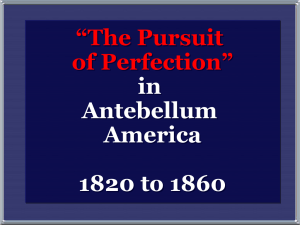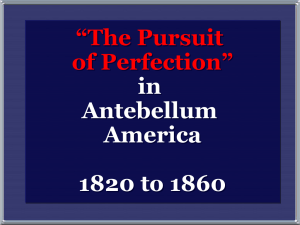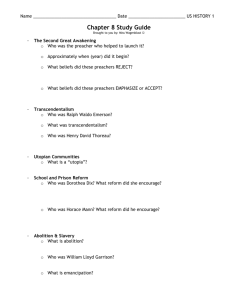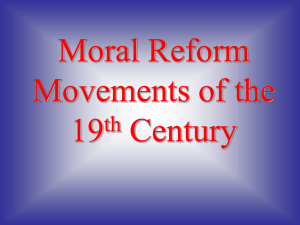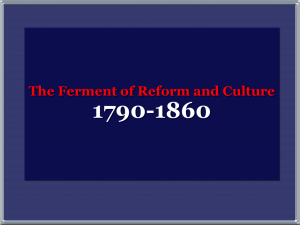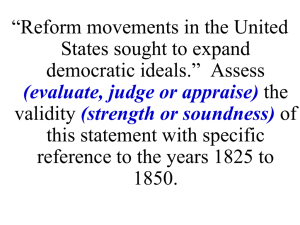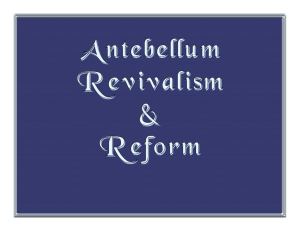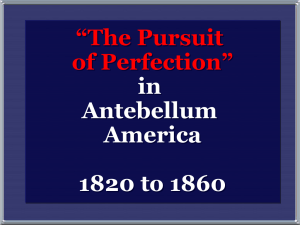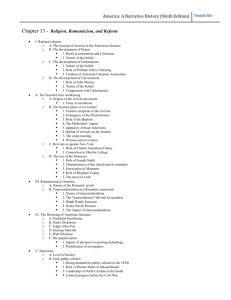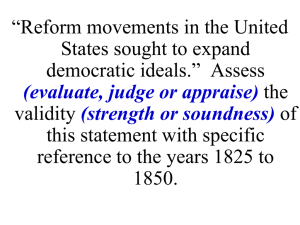21AgeofReform - Thomas County Schools
advertisement
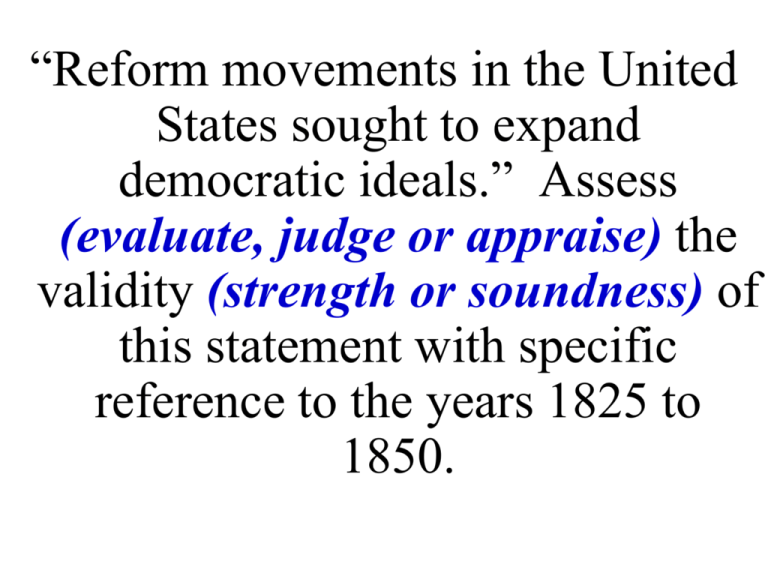
“Reform movements in the United States sought to expand democratic ideals.” Assess (evaluate, judge or appraise) the validity (strength or soundness) of this statement with specific reference to the years 1825 to 1850. “The Pursuit of Perfection” In Antebellum America 1820 to 1860 The Second Great Awakening “Spiritual Reform From Within” [Religious Revivalism] Social Reforms & Redefining the Ideal of Equality Temperance Education Abolitionism Asylum & Penal Reform Women’s Rights 1. Ante-Belleum—1820 to 1860 • Romantic age • Reformers pointed the inequality in society • Industrialization vs. progress in human rights • Primarily a Northern movement • Southerner’s refused reforms to protect slavery. • Educated society through • newspaper and lyceum meetings • Areas to reform: • Slavery women’s rights • Industrialization public school • Male domination temperance (alcohol) • War prison reform Temperance Movement • The most significant reform movements of the period sought not to withdraw from society but to change it directly • Temperance Movement — undertook to eliminate social problems by curbing drinking – Led largely by clergy, the movement at first focused on drunkenness and did not oppose moderate drinking – In 1826 the American Temperance Society was founded, taking voluntary abstinence as its goal. •Lyman Beecher •Neal Dow •Lucretia Mott •Anti-Alcohol movement •American Temperance Society formed at Boston-----1826 • sign pledges, pamphlets, anti-alcohol tract 10 nights in a Barroom and What I Saw There •Demon Drink adopt 2 major line attack •stressed temperance and individual will to resist The Drunkard’s Progress From the first glass to the grave, 1846 Educational Reform In 1800 Massachusetts was the only state requiring free public schools supported by community funds Middle-class reformers called for tax-supported education, arguing to business leaders that the new economic order needed educated workers The Asylum Movement (orphanages, jails, hospitals) • Asylums isolated and separated the criminal, the insane, the ill, and the dependent from outside society • “Rehabilitation” – The goal of care in asylums, which had focused on confinement, shifted to the reform of personal character The Asylum Movement • Dorothea Dix, a Boston schoolteacher, took the lead in advocating state supported asylums for the mentally ill • She attracted much attention to the movement by her report detailing the horrors to which the mentally ill were subjected – being chained, kept in cages and closets, and beaten with rods • In response to her efforts, 28 states maintained mental institutions by 1860 Abolitionist Movement 1816 --> American Colonization Society created (gradual, voluntary emancipation. British Colonization Society symbol Abolitionist Movement Create a free slave state in Liberia, West Africa. No real anti-slavery sentiment in the North in the 1820s & 1830s. Gradualists Immediatists Abolitionism • William Lloyd Garrison, publisher of the The Liberator, first appeared in 1831 and sent shock waves across the entire country – He repudiated gradual emancipation and embraced immediate end to slavery at once – He advocated racial equality and argued that slaveholders should not be compensated for freeing slaves. The Liberator Premiere issue January 1, 1831 Abolitionism • Free blacks, such as Frederick Douglass, who had escaped from slavery in Maryland, also joined the abolitionist movement • To abolitionists, slavery was a moral, not an economic question • But most of all, abolitionists denounced slavery as contrary to Christian teaching • 1845 --> The Narrative of the Life Of Frederick Douglass • 1847 --> “The North Star” Anti-Slavery Alphabet Black Abolitionists David Walker (1785-1830) 1829 --> Appeal to the Colored Citizens of the World Fight for freedom rather than wait to be set free by whites. Sojourner Truth (1787-1883) 1850 --> The Narrative of Sojourner Truth R2-10 The Underground Railroad “Conductor” ==== leader of the escape “Passengers” ==== escaping slaves “Tracks” ==== routes “Trains” ==== farm wagons transporting the escaping slaves “Depots” ==== safe houses to rest/sleep Growth of slavery Growth of slavery Abolitionism: Division and Opposition Abolitionism forced the churches to face the question of slavery head-on, and in the 1840s the Methodist and Baptist churches each split into northern and southern organizations over the issue of slavery Even the abolitionists themselves splintered More conservative reformers wanted to work within established institutions, using churches and political action to end slavery Early 19c Women 1. Unable to vote. 2. Legal status of a minor. 3. Single --> could own her own property. 4. Married --> no control over her property or her children. 5. Could not initiate divorce. 6. Couldn’t make wills, sign a contract, or bring suit in court without her husband’s permission. “Separate Spheres” Concept Republican Motherhood evolved into the “Cult of Domesticity” A woman’s “sphere” was in the home (it was a refuge from the cruel world outside). Her role was to “civilize” her husband and family. An 1830s MA minister: The power of woman is her dependence. A woman who gives up that dependence on man to become a reformer yields the power God has given her for her protection, and her character becomes unnatural! Cult of Domesticity = Slavery The 2nd Great Awakening inspired women to improve society. Angelina Grimké Sarah Grimké Southern Abolitionists R2-9 Lucy Stone American Women’s Suffrage Assoc. edited Woman’s Journal Educational Reform Under Horace Mann’s leadership in the 1830s, Massachusetts created a state board of education and adopted a minimumlength school year. Provided for training of teachers, and expanded the curriculum to include subjects such as history and geography Educational Reform By the 1850s the number of schools, attendance figures, and school budgets had all increased sharply School reformers enjoyed their greatest success in the Northeast and the least in the South Southern planters opposed paying taxes to educate poorer white children Educational opportunities for women also expanded In 1833 Oberlin College in Ohio became the first coeducational college. Four years later the first all-female college was founded — Mount Holyoke, Massachusetts Women Educators Troy, NY Female Seminary curriculum: math, physics, history, geography. train female teachers Emma Willard (1787-1870) 1837 --> she established Mt. Holyoke [So. Hadley, MA] as the first college for women. Mary Lyons (1797-1849) Women’s Rights Movement When abolitionists divided over the issue of female participation, women found it easy to identify with the situation of the slaves 1848: Feminist reform led to Seneca Falls Convention Significance: launched modern women’s rights movement Established the arguments and the program for the women’s rights movement for the remainder of the century What It Would Be Like If Ladies Had Their Own Way! Women’s Rights 1840 --> split in the abolitionist movement over women’s role in it. London --> World Anti-Slavery Convention Lucretia Mott Elizabeth Cady Stanton 1848 --> Seneca Falls Declaration of Sentiments The first Woman’s rights movement was in Seneca Falls, New York in 1849…… •Educational and professional opportunities •Property rights •Legal equality •repeal of laws awarding the father custody of the children in divorce. •Suffrage rights •The following is an excerpt from the Seneca Falls Declaration written by Elizabeth Cady Stanton. •Notice that the language and wording is similar to the Declaration of Independence. We hold these truths to be selfevident that all men and women are created equal; that they are endowed by their Creator with certain inalienable rights; that among these are life, liberty and the pursuit of happiness; that to secure these rights governments are instituted, deriving their just powers from the consent of the governed…… The history of mankind is a history of repeated injuries and usurpations on the part of man toward woman, having in direct object the establishment of an absolute tyranny over her. To prove this, let facts be submitted to a candid world…. •He has made her, if married, in the eye of the law, civilly dead. •He has taken from all right in property, even to the wages she earns. nd 2 The Great Awakening Second Great Awakening • As a result of the Second Great Awakening (a series of revivals in the 1790s-early 1800s), the dominant form of Christianity in America became evangelical Protestantism – Membership in the major Protestant churches— Congregational, Presbyterian, Baptist, and Methodist—soared – By 1840 an estimated half of the adult population was connected to some church, with the Methodists emerging as the largest denomination in both the North and the South Revivalism and the Social Order • Society during the Jacksonian era was undergoing deep and rapid change – The revolution in markets brought both economic expansion and periodic depressions. • To combat this uncertainty reformers sought stability and order in religion – Religion provided a means of social control in a disordered society – Churchgoers embraced the values of hard work, punctuality, and sobriety – Revivals brought unity and strength and a sense of peace The Rise of African American Churches • Revivalism also spread to the African American community • The Second Great Awakening has been called the "central and defining event in the development of AfroChristianity“ • During these revivals Baptists and Methodists converted large numbers of blacks The Rise of African American Churches • This led to the formation of allblack Methodist and Baptist churches, primarily in the North • African Methodist Episcopal (A. M. E.) had over 17,000 members by 1846 Other Churches Founded • While the Protestant revivals sought to reform individual sinners, others sought to remake society at large • Mormons – The Church of Jesus Christ of Latter-Day Saints • Founded by Joseph Smith in western NY •In 1827, Smith announced that he had discovered a set of golden tablets on which was written the Book of Mormon •Proclaiming that he had a commission from God to reestablish the true church, Smith gathered a group of devoted followers Mormons • Mormon culture upheld the middle-class values of hard work, self-control, and • He tried to create a City of Zion: Kirkland, Ohio, Independence, Missouri, then to Nauvoo, Illinois. • His unorthodox teachings led to persecution and mob violence. • Smith was murdered in 1844 by an antiMormon mob in Carthage, Illinois. • Church in conflict Mormons • Brigham Young, Smith’s successor, led the Mormons westward in 1846-1847 to Utah where they could live and worship without interference Cults • The Shakers – Ann Lee – 1774 – The Shakers used dancing as a worship practice – Shakers practiced celibacy, separating the sexes as far as practical – Shakers worked hard, lived simply (built furniture), and impressed outsiders with their cleanliness and order – Lacking any natural increase, membership began to decline after 1850, from a peak of about 6000 members Utopian Communities • • • • The Oneida Community Brook Farm New Harmony Transcendentalists Secular Utopian Communities Individual Freedom Demands of Community Life spontaneity discipline self-fulfillment organizational hierarchy The Oneida Community New York, 1848 Millenarianism --> the 2nd coming of Christ had already occurred. Humans were no longer obliged to follow the moral rules of the past. • all residents married John Humphrey Noyes (1811-1886) to each other. • carefully regulated “free love.” Transcendentalism “Liberation from understanding and the cultivation of reasoning.” “Transcend” the limits of intellect and allow the emotions, the SOUL, to create an original relationship with the Universe. Transcendentalist Intellectuals/Writers Concord, MA Ralph Waldo Emerson Nature (1832) Self-Reliance (1841) “The American Scholar” (1837) Henry David Thoreau Walden (1854) Resistance to Civil Disobedience (1849)
